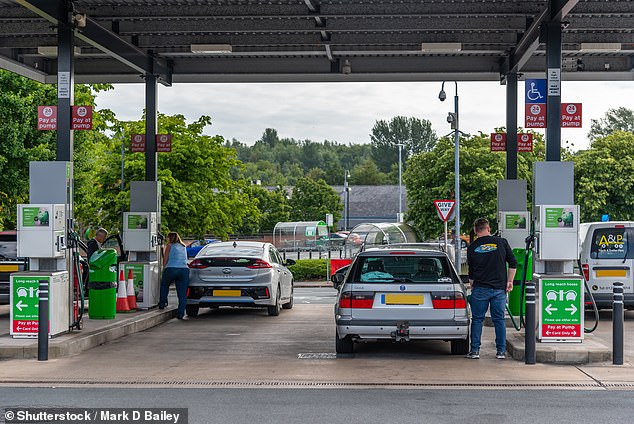Table of Contents
UK petrol prices have fallen to their lowest level in six months, the AA confirmed on Friday morning.
In good news for beleaguered motorists, the average price has dropped to 143p a litre this week, the lowest level since February.
But the relief could be short-lived amid stark warnings to drivers that they face an era of “permanently high” fuel costs as fears mount that the new Labour government will raise fuel taxes for the first time in almost a decade and a half.
The average price of petrol is now 143p a litre this week, the lowest in six months.
There have been small rises and falls in petrol prices over the summer: in April the price per litre was 150.1 pence, in June 144.5 pence and in July 145.3 pence.
Currently at 143.0 pa/litre, the petrol level is the lowest since mid-February, while diesel has also dropped to 147.9 pa/litre, a level last seen in late January.
While there hasn’t been much to celebrate for motorists this summer, the 5p cut in fuel duty that remains in place has been a small victory. With VAT included, drivers save 6p at the pump.
Had the fuel duty cut not been implemented in March 2022, UK motorists would have endured average petrol prices of more than 150p per litre from 21 February to 8 August.
Before Covid, the worst prices UK motorists had ever suffered were 142.48 per litre in April 2012.
‘Fuel prices this summer have given UK drivers little reason to celebrate.
“They may be well below the record 191.53p for petrol in July 2022, but they are currently stuck at a permanent and historically high level that is draining consumers’ finances,” says AA spokesman on road fuel costs Luke Bosdet.
The AA recently expressed concern about “permanently high” road fuel costs, which will hit families, businesses and workers particularly hard.
This is Money reported that a trifecta of fuel tax increases, commodity price surges and higher retailer margins could cause real financial difficulties.
The most pressing concern is that Labour will raise fuel duty in its October budget.
If the Treasury increases fuel duty on top of fuel retailers’ “inflated” margins and already high commodity prices, it will “condemn UK families” to huge outlays on the cost of fuel and travel, the AA says.
How will a fuel tax increase affect living wage workers?
The AA analysed the impact of the removal of the 5p (6p including VAT) cut in fuel duty on minimum wage workers who drive a significant distance to work or during their commute. These are employees who work 40 hours a week at £11.44 an hour and currently take home £20,653.94 a year.
In April 2022, the same living wage worker, earning £9.50 an hour, took home £17,748.60 a year, a difference of £2,905.34.
If the 5p cut in fuel duty were removed, the result would be a 6p per litre increase in the price of fuel and an added £3.30 to the cost of filling a typical 55-litre car tank of fuel.
For a worker who refuels once a week, the annual increase in fuel costs would be £171.60.
For someone who refuels every fortnight, the additional annual fuel cost would be £85.80.
A worker who fills out his insurance once a week would then lose 5.9 percent of the benefit obtained from the increases in the minimum wage over the last two years.
An employee who fills out his payroll once every two weeks would lose 2.95 percent.
What is causing gasoline prices to skyrocket?
There are several factors at play here:
In the five years before Covid-19 and the war in Ukraine, Brent crude oil cost $60 a barrel. Now it is $80.
The industry standard is a 1p per litre charge at the pump for every $2 per barrel change in the price of oil, meaning the $20 increase has led to a £5.50 jump in the cost of filling a typical 55-litre tank of fuel.
And retailers’ margins are adding more than 6p a litre to the cost of petrol.

A combination of three factors is driving up gasoline costs: Crude oil now costs $20 a barrel more than it did five years ago.
In his Provisional update of fuel consumption control on the road Last week, the Competition and Markets Authority reported that “petrol retail spreads in the four months to June averaged 12.62ppl, which was 2.55ppl lower than in the previous four months but still more than double the average of 6.51ppl during 2015-19.”
Those 6 people equate to an extra £3.30 that drivers have to shell out.
Then there is the triple whammy of a weaker pound. Current exchange rates mean the pound is worth less than $1.30, compared with $1.40 before Brexit. Once commodity prices are pegged to these rates, the motorist will be left with an extra £1.90 on every tank of petrol.
How much does the Treasury generate from the fuel tax?
Fuel taxes represent an important source of revenue for the Government.
The OBR says fuel taxes levied on purchases of petrol, diesel and a range of other fuels raise £24.4bn a year for the Treasury.
That estimate includes a 5p per litre cut and a tax rate of 52.95p per litre.
This represents 2.3 per cent of all income and is equivalent to £867 per household and 0.9 per cent of national income.

Some links in this article may be affiliate links. If you click on them we may earn a small commission. This helps us fund This Is Money and keep it free to use. We do not write articles to promote products. We do not allow any commercial relationships to affect our editorial independence.


